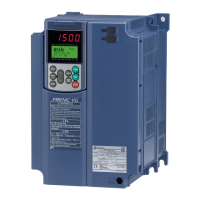2-18
Table 2.9 Symbols, Names and Functions of the Control Circuit Terminals (Continued)
Classifi-
cation
Symbol Name Functions
- Since low level analog signals are handled, these signals are especially susceptible to
the external noise effects. Route the wiring as short as possible (within 66ft (20 m))
and use shielded wires. In principle, ground the shielded sheath of wires; if effects of
external inductive noises are considerable, connection to terminal [11] may be
effective. As shown in Figure 2.13, ground the single end of the shield to enhance the
shield effect.
- Use a twin contact relay for low level signals if the relay is used in the control circuit.
Do not connect the relay's contact to terminal [11].
- When the inverter is connected to an external device outputting the analog signal, a
malfunction may be caused by electric noise generated by the inverter. If this
happens, according to the circumstances, connect a ferrite core (a toroidal core or an
equivalent) to the device outputting the analog signal and/or connect a capacitor
having the good cut-off characteristics for high frequency between control signal wires
as shown in Figure 2.14.
- Do not apply a voltage of +7.5 VDC or higher to terminal [C1] when you assign the
terminal [C1] to C1 function. Doing so could damage the internal control circuit.
Analog input
Figure 2.13 Connection of Shielded Wire Figure 2.14 Example of Electric Noise Reduction
[X1] Digital
input 1
[X2] Digital
input 2
[X3] Digital
input 3
[X4] Digital
input 4
[X5] Digital
input 5
(1) Various signals such as coast-to-stop, alarm from external equipment,
and multi-frequency commands can be assigned to terminals [X1] to
[X5], [FWD] and [REV] by setting function codes E01 to E05, E98, and
E99. For details, refer to Chapter 5, Section 5.2 "Overview of Function
Codes."
(2) Input mode, i.e. SINK/SOURCE, is changeable by using the internal slide
switch. (Refer to Section 2.3.7, "Setting up the slide switches."
(3) Switches the logic value (1/0) for ON/OFF of the terminals [X1] to [X5],
[FWD], or [REV]. If the logic value for ON of the terminal [X1] is 1 in the
normal logic system, for example, OFF is 1 in the negative logic system
and vice versa.
(4) The negative logic system never applies to the terminals assigned for
FWD and REV.
[FWD] Run
forward
command
Digital input
[REV] Run
reverse
command
(Digital input circuit specifications)
Figure 2.15 Digital Input Circuit
Item Min. Max.
ON level 0 V 2 V
Operation
voltage
(SINK)
OFF level 22 V 27 V
ON level 22 V 27 V
Operation
voltage
(SOURCE)
OFF level 0 V 2 V
Operation current at
ON
(Input voltage is at 0 V)
2.5 mA 5 mA
Allowable leakage
current at OFF
- 0.5 mA

